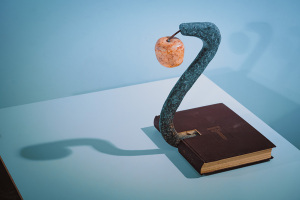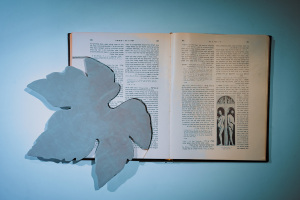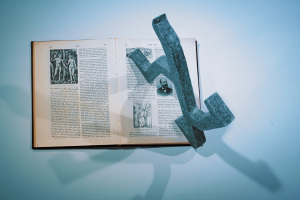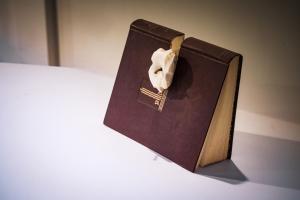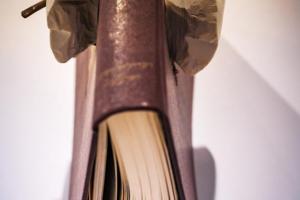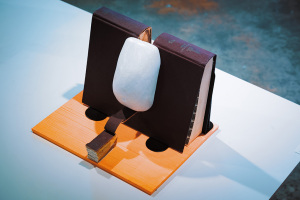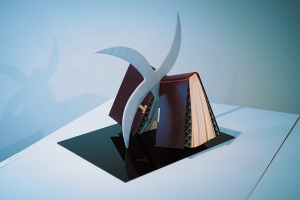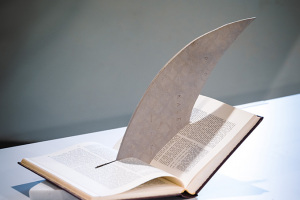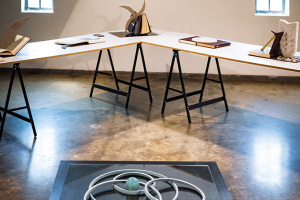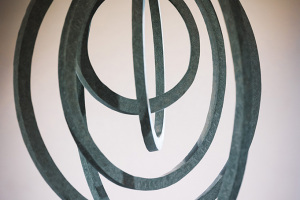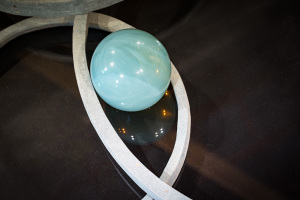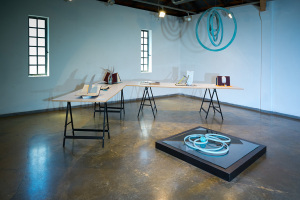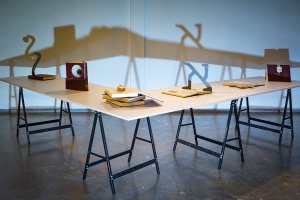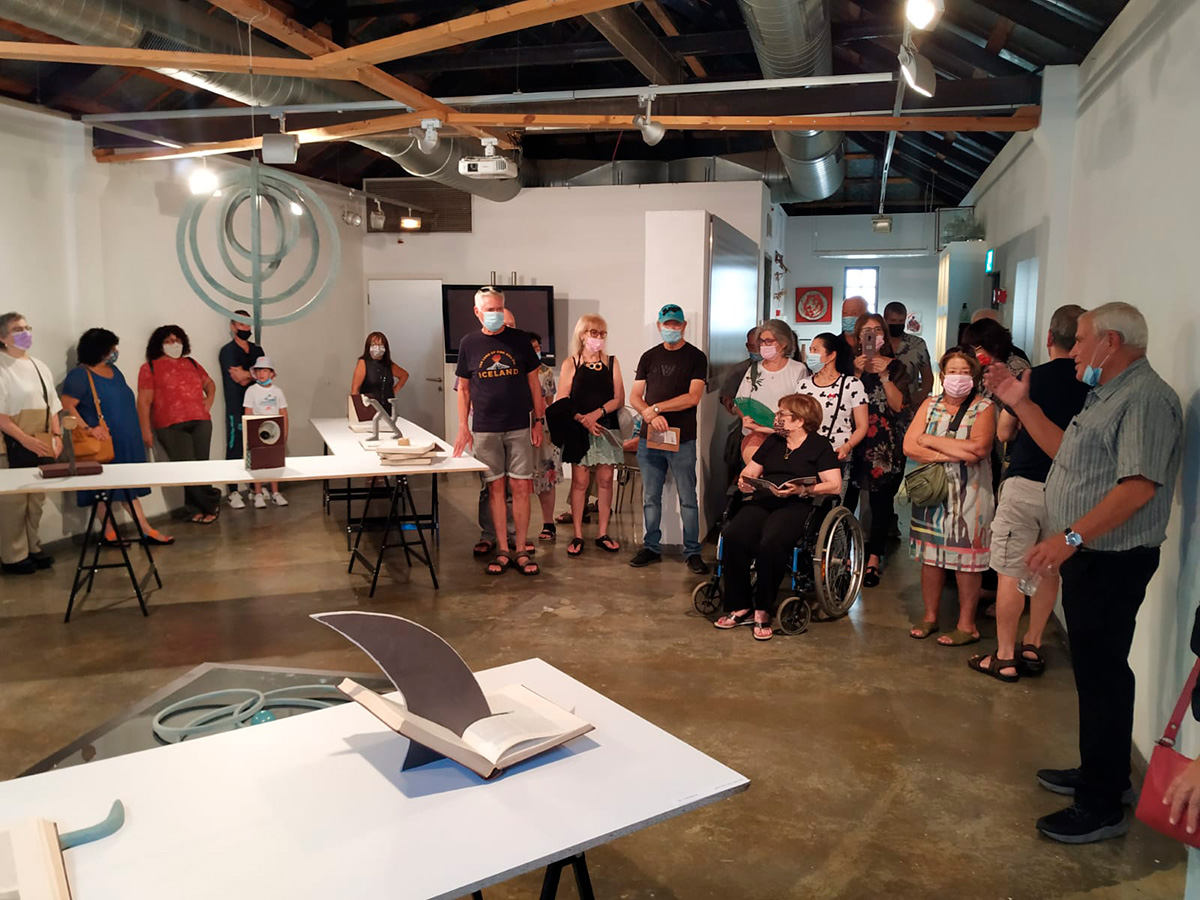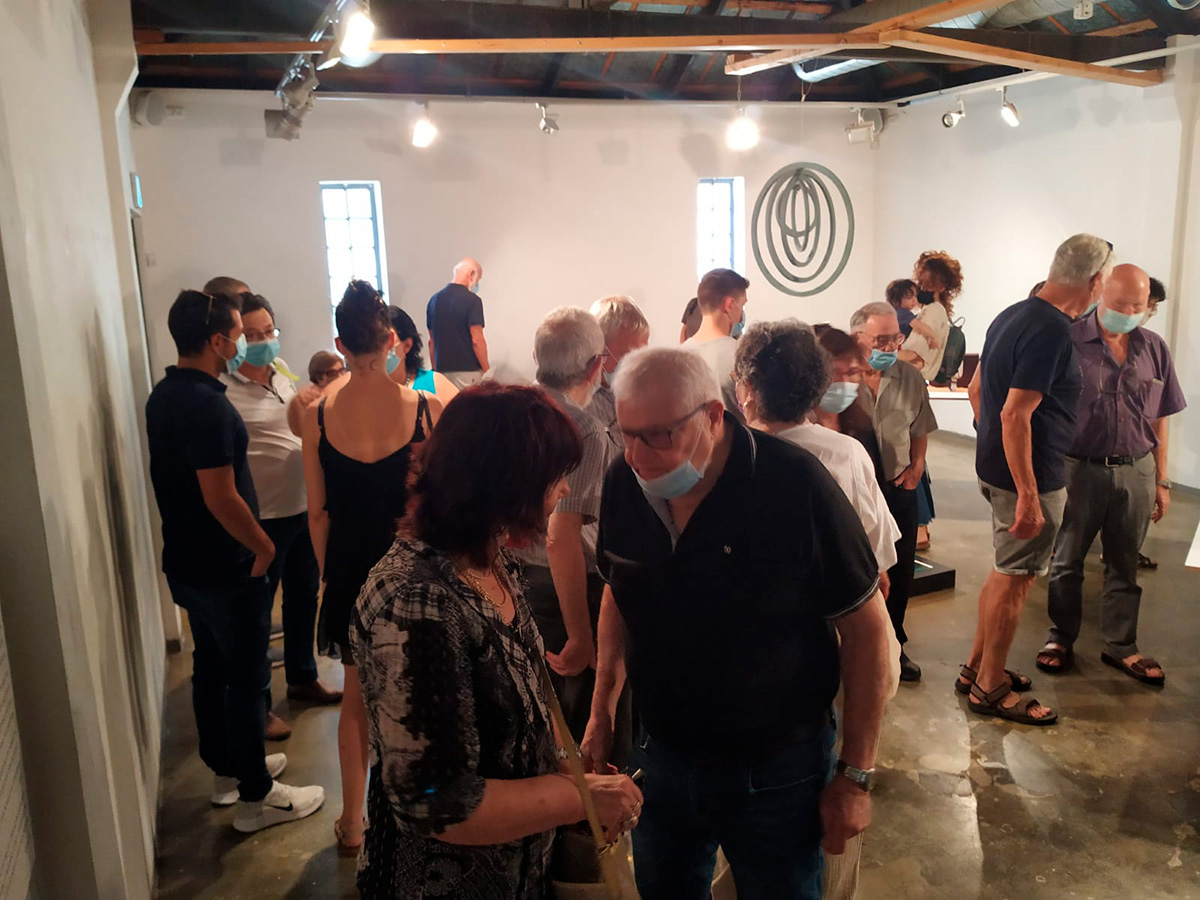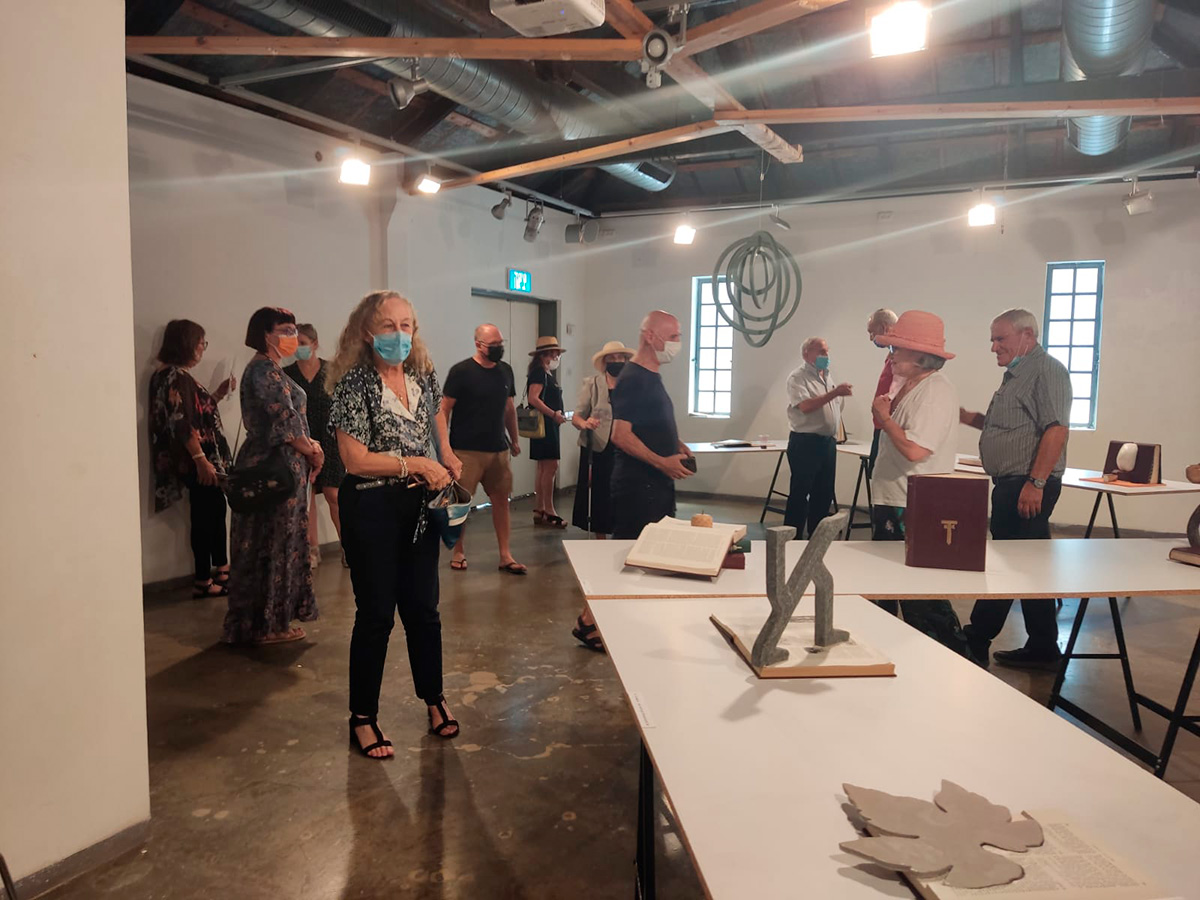From Eternal Life to Life and Death
Avi Sperber has created a series of stone sculptures connected to books, allegorical works that act as metaphors for the story of sin and punishment in the Book of Genesis.
The sculptures give three-dimensional expression to the duality of the artist’s feelings. On the one hand, he uses them to translate conceptual content in light of his artistic understanding, nourished by an analysis of the human mind, and on the other hand, he uses them to create empathetic, immediate, emotional, and even romantic expressions of his feelings.
The use in these works of stone – an eternal substance, linking the past and the future, together with organic materials that “lock horns” with the latest industrial materials – creates a dramatic and extraordinary relationship in the eyes of the viewer. There is tension between the books, which serve as a Jewish symbol (“people of the Book”), suitable for a wandering and mobile people, and stone, which is tied to a specific place and landscape, evidence of a mythical and historical link to a defined site.
Avi Sperber creates a renewed expression of the story of the third chapter in the Book of Genesis, the chapter in which the first couple, Adam and Eve, make an appearance and which describes the first sin and the expulsion from the Garden of Eden. This is the most human, the most fascinating and the most allegorical chapter to be found in the whole of Genesis. The story of the woman’s temptation by the serpent, and the Creator’s curse of Adam and his wife, is still the inspiration for endless works of art.
In my opinion, this chapter defines a number of mythical and immortal facts of life. The first is the possibility of man distinguishing between good and evil. The second is the subject of giving birth in sorrow and man’s control over women. The third is the curse of the soil for man, and his return to it at the end of his life. The fourth is the whirling sword which guards the tree of life from man. All these are incomparable visual symbols for representation in three-dimensional sculpture.
Avi Sperber created this series in the craziest and most unfamiliar period of this millennium, during the covid epidemic, which has cut us off from the flow of normal life for a year. This may be a small exhibition, but it has profound and fateful significance, and makes us stop and think about our lives and our future.
Doron Polack/ Exhibition Curator
Chapter C
Man, like every living thing, will die. Death is unavoidable. Man, like an animal that is terrified by every danger and especially by one that threatens its life, tries to escape. But man is an intelligent animal. He thinks, understands, investigates, is not satisfied by merely knowing about the existence of death and never stops looking for ways to overcome it, in an attempt to escape it and fulfill his yearning for eternal life.
The story of the creation of the world and man runs through the myths and legends of other peoples in different forms. In the monotheistic religions, following the creation of the world, the beginning of human civilization is found in the Garden of Eden, where man was created by God, the eternal force that controls everything.
The Garden of Eden is the place of the beginning of all things and the eternal source of the patterns of life. It is the object of longing, yearning, and the hope of reward manifested in eternal life. In the words of Walter Benjamin: “Paradise is the origin of man, but also a utopian vision of his future redemption.”
The third chapter of the Book of Genesis describes the birth of civilized man, the man with a tireless urge to know. The story is an allegorical fusion of characters and processes that represent various components of human life, which have been interpreted over the generations by many people in different ways and led to the beliefs that affect our lives to this day.
When their eyes were opened, Adam and Eve experienced shame for the first time. They understood that they were similar yet different; their organs defined their identity – man and woman. By covering their private parts with fig leaves they expressed their recognition of their differences and their desire to maintain privacy and intimacy. The determination of gender becomes more powerful as the story proceeds, particularly in the punishments imposed on them by God: the woman will bear children in sorrow and the man will live by the sweat of his brow and will rule over the woman. This patriarchal definition of the relationship between man and woman has determined relations between the sexes for many generations.
Adam and Eve discovered fear, too, when their eyes were opened, and they hid from God when they heard his voice in the Garden. This fear also explains man’s relationship with God. God asks, “Where art thou?” although he knows where Adam is. “Big Brother” represents the relationship between ruler and ruled, between the one who transgresses and the one who punishes.
The Garden of Eden was nature, the home of the animals. Man, too, was part of nature. He ate, drank, did not understand and did not know. The serpent in the story is a wild creature of the field – it represents nature, but it is craftier than any of the other animals, and was therefore chosen as mediator between nature and civilization. It tempts Eve, and through her it transfers knowledge, wisdom and civilization, removing him from nature. Some say that language was born at the moment when Adam gave warning of the serpent’s presence. Later, people developed written communication, first in the form of shapes carved in stone, and later with letters and fonts. The serpent brought language and culture to man, petroglyphs evolved into books and, as human society spread throughout the world, human culture took on many different shades.
There is an interpretation that the serpent tempted Eve because there was love between them (in parentheses, Aphrodite also offered an apple as a promise of love). Other interpretations, mainly Christian ones, are fed by the idea of celibacy and the patriarchal approach. Eve is presented as the one who tempted Adam and thus caused him to commit the sin of lust. And for that reason, all her daughters, that is, all women, are guilty of the sin.
The Tree of the Knowledge of Good and Evil is called “the tree upon which death depends.” It is the origin of the start of human civilization and human fate. Eating its fruit brought understanding, consciousness and knowledge, but also brought the sentence of death.
Eating the fruit of the Tree of Knowledge set everything in motion. Man, who was part of nature, had his eyes opened to understand the world around him. He began to see the questions raised by knowledge, moral questions of good and evil, of what is forbidden and what is permitted, questions about the relationship between men and women, questions about the relationship between the ruler and the ruled, and the relationship between man and God. Man learned about shame, guilt and fear, about commands and prohibitions, about sins and punishments, and the difference between the eternal and the ephemeral.
The third chapter ends with man’s expulsion from the Garden of Eden, that is, from nature to the space of knowledge and culture.
Adam, at the moment when the gates of the Garden of Eden closed behind him, suddenly faced an unknown world. He knew he had to go on, to move forward, but to where? In fact, this is the beginning of the odyssey towards an unknown, unclear civilization, a never-ending journey. Today, as throughout history, we stand in that same spot, facing social, technological and economic developments leading to an uncharted civilization.
Ever since man’s expulsion from the Garden, he has been troubled by that question of finality – death. In his attempt to escape his fate, he has developed various beliefs in the resurrection of the dead and reincarnation. In Judaism there is the expectation and belief that the Messiah will come, bringing with him the resurrection of the dead. The ancient Egyptians believed that the dead pass over to the world of the dead where they continue a kind of life and, when the time comes, will return to life on earth. In Kabbalah there is a belief that man is reborn and rises through the spheres on the basis of his good deeds in life, with the goal of reaching God and uniting with him. The Indians, the Druze and many others all believe in reincarnation.
All these are man’s attempts to return to the Garden of Eden, but this object of yearning poses a dilemma for man, between eternal life – which means a desire to return to the past, to nature, to live as one of the animals – and the lust for strength, to develop abilities and knowledge while looking to the future – to become like God.
The exhibition presents the text of the third chapter by means of symbols that represent the words and actions in it, thus presenting a picture of the continuity of events in the creation of human civilization.
The materials used in the sculptures, stone and book (ready-made), represent the same idea. Stone is a natural material, and the book is language, the material of civilization. The books are volumes of the Hebrew Encyclopedia, a comprehensive Hebrew-language encyclopedia, which was published with the establishment of the State of Israel in 1948. Today, with the development of technology and the enormous range of information on the internet, there is hardly any use for it, and its volumes are sent for recycling, so it represents the ephemeral object – man.
Avi Sperber
